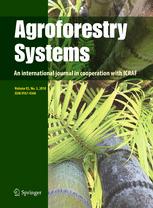Ver ítem
- xmlui.general.dspace_homeCentros Regionales y EEAsCentro Regional Tucumán - Santiago del EsteroEEA Santiago del EsteroArtículos científicosxmlui.ArtifactBrowser.ItemViewer.trail
- Inicio
- Centros Regionales y EEAs
- Centro Regional Tucumán - Santiago del Estero
- EEA Santiago del Estero
- Artículos científicos
- Ver ítem
Yield and growth features of Panicum maximum (Jacq.) var Trichoglume cv Petrie (Green Panic) under woody cover, Chaco region, Argentina
Resumen
Secondary forests and shrub thickets with low suitability for cattle raising are widespread in the Chaco region (NW Argentina). Concerns about the ecological sustainability of these ecosystems favor vegetation clearing methods for improving standing forage and accessibility for livestock operations that retain native tree and shrub species, a system called ‘silvopasture’ locally. These areas are characterized by a reduction of sunlight availability if
[ver mas...]
Secondary forests and shrub thickets with low suitability for cattle raising are widespread in the Chaco region (NW Argentina). Concerns about the ecological sustainability of these ecosystems favor vegetation clearing methods for improving standing forage and accessibility for livestock operations that retain native tree and shrub species, a system called ‘silvopasture’ locally. These areas are characterized by a reduction of sunlight availability if compared with treeless pastures. The objective of this research was to assess the growth rate and the effect of two harvesting intervals (15 and 30 days) on the annual yield (BM) and forage quality of Panicum maximum (Jacq.) var Trichoglume cv Petrie (Green Panic) in such a system, using two approaches: successive harvests and functional, during three growth seasons (2000–01, 2001–02 and 2002–03). Correlation of growth features of Green panic with rainfall (mm), growing degree days (°C, GDD), and soil moisture (%) at two soil depths (0–15 and 15–30 cm) was also assessed. BM varied between 3,500 and 11,500 kg dry matter ha−1. The absolute growth rate presented two annual peaks, located in early and late summer, irrespective of growth season and harvesting interval. Growth season and harvesting interval significantly affected the relative growth rate (p > F = 0.0015 and p > F = 0.0002, respectively). BM was significantly correlated with rainfall and GDD observed between sampling dates, the magnitude of the coefficients were higher for the 30-day than for the 15-day harvesting interval. Correlation between BM and soil moisture content was not significant for both soil depths. Resting periods should be longer than 30 days to maintain the stability of the grazing system.
[Cerrar]

Fuente
Agroforestry systems 88 (1) : 157–171. (February 2014)
Fecha
2014-02
ISSN
0167-4366
1572-9680
1572-9680
Formato
pdf
Tipo de documento
artículo
Palabras Claves
Derechos de acceso
Restringido
 Excepto donde se diga explicitamente, este item se publica bajo la siguiente descripción: Creative Commons Attribution-NonCommercial-ShareAlike 2.5 Unported (CC BY-NC-SA 2.5)
Excepto donde se diga explicitamente, este item se publica bajo la siguiente descripción: Creative Commons Attribution-NonCommercial-ShareAlike 2.5 Unported (CC BY-NC-SA 2.5)

